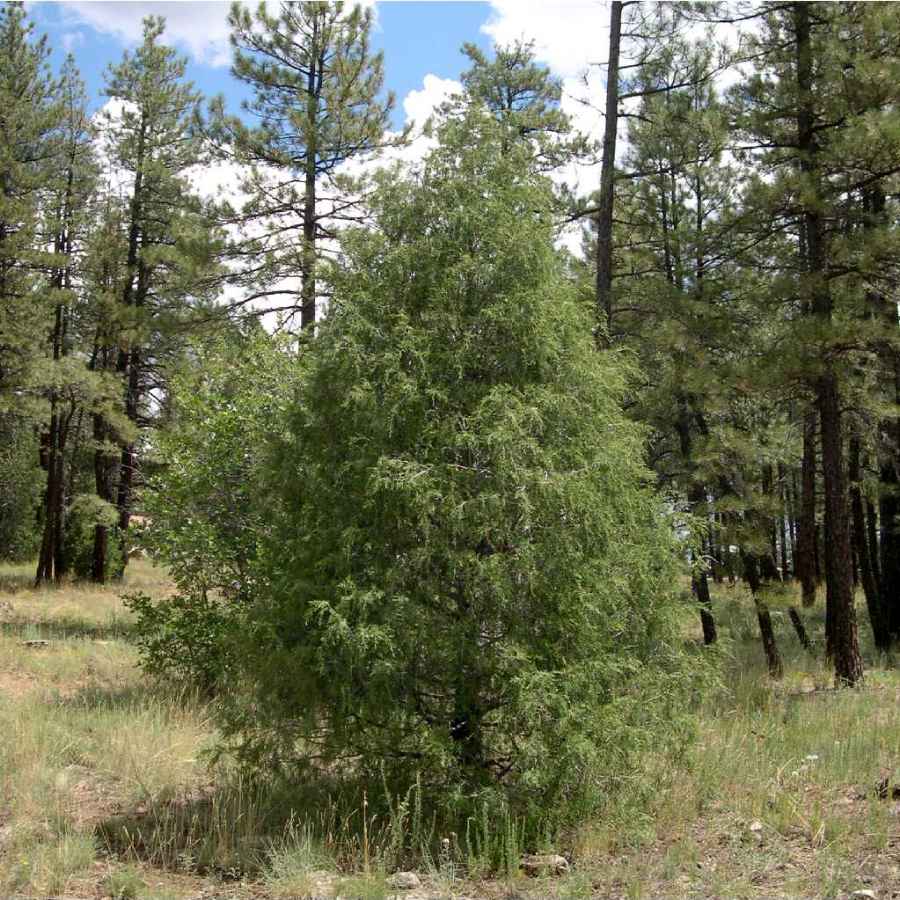Juniperus
|
Family: Cupressaceae |
Shrubs or trees evergreen. Branchlets terete, 3--6 angled, variously oriented, but not in flattened sprays. Leaves opposite in 4 ranks or in whorls of 3. Adult leaves closely appressed to divergent, scalelike to subulate, free portion to ca. 10 mm (to ca. 15 mm in Juniperus communis ); abaxial gland visible or not, elongate to hemispheric ( J . ashei ), sometimes exuding white crystalline deposit. Pollen cones with 3--7 pairs or trios of sporophylls, each sporophyll with 2--8 pollen sacs. Seed cones maturing in 1 or 2 years, globose to ovoid and berrylike, 3--20 mm, remaining closed, usually glaucous; scales persistent, 1--3 pairs, peltate, tightly coalesced, thick and fleshy or fibrous to obscurely woody. Seeds 1--3 per scale, round to faceted, wingless; cotyledons 2--6. x = 11. Juniperus is the only dioecious (sometimes monoecious) genus of Cupressaceae in the flora. Cones, generally terminal, are axillary in J . communis . Numerous cultivars of Juniperus species are widely used for landscaping. Mutants, or 'sports,' affecting plant habit and foliage are present in all species and are likely related to single-gene mutations. Many have been given formal names or incorrectly ascribed to hybridization. Gymnocarpy (bare seeds protruding from the cone), caused by insect larvae (T. A. Zanoni 1978), is occasionally found in most junipers, particularly in the southwestern United States. Specimens with such aberrations may be almost impossible to identify without chemical data.
PLANT: Shrubs or trees, usually dioecious. STEMS: short shoots 4 angled to cylindric; bark usually thin, peeling in strips or in one species thick, deeply fissured into rectangular plates. LEAVES: decussate or tricussate; scale-like to less often awl- or needle-like. POLLEN CONES: 3-5 mm long; sporophylls 6-24, decussate or tricussate; pollen sacs 2-8 per sporophyll. SEED CONES: 3-20 mm long, fleshy to fibrous to rarely obscurely woody, berry-like, dry or fleshy, flavorless to resinous (bitter) to sweet, usually glaucous, formed by fusion of scales, more or less spheric, surrounded at base by minute scale-like bracts; scales 3-8, decussate or tricussate. SEEDS: 1-3 per scale, terete or angled, unwinged, usually dispersed by animals; cotyledons 2-6. NOTES: ca. 60 spp; N. Hemisphere. (Latin name for juniper). Adams, R.P. and T.A. Zanoni. 1979. Southw. Naturalist 24:323-329; Vasek, F.C. 1966. Brittonia 18:350-372; Zanoni, T.A. 1978. Phytologia 38:433-454. REFERENCES: Bartel, Jim A. 1994. Cupressaceae. J. Ariz. - Nev. Acad. Sci. Volume 27, 195-200. Female cones indehiscent, berry-like or drupe-like, usually colored (commonly bluish), the several scales coalescent and somewhat fleshy at maturity; seeds 1-10 per cone, wingless; male cones with numerous microsporophylls; dioecious or occasionally monoecious shrubs or small trees with scale-like or needle-like lvs opposite or whorled in 3's; 2n=22. 60, mainly N. Temp. Gleason, Henry A. & Cronquist, Arthur J. 1991. Manual of vascular plants of northeastern United States and adjacent Canada. lxxv + 910 pp. ©The New York Botanical Garden. All rights reserved. Used by permission. |

